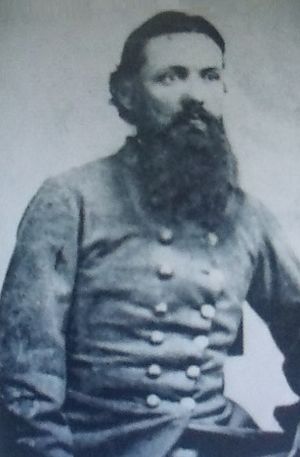Edward Tiffin Harrison Warren facts for kids
Quick facts for kids
Edward T. H. Warren
|
|
|---|---|

Edward T. H. Warren
|
|
| Born | June 19, 1829 Harrisonburg, Virginia |
| Died | May 5, 1864 (aged 34) Locust Grove, Orange County, Virginia |
| Place of burial |
Woodbine Cemetery, Harrisonburg, Virginia
|
| Allegiance | |
| Service/ |
|
| Years of service | 1861–65 (CSA) |
| Rank | |
| Battles/wars | American Civil War |
Edward Tiffin Harrison Warren (June 19, 1829 – May 5, 1864) was a military colonel who commanded a Virginia infantry regiment in the Army of Northern Virginia during the American Civil War. He was killed in the Battle of the Wilderness on May 5, 1864.
Pre-war
Warren was born in Harrisonburg, Virginia, where he practiced law before the war. He married Virginia Magruder, known as Jennie, in 1855 at Frascati in Orange County. They lived, beginning in 1856, at what is now the E.T.Warren-Sipe House. (The house served as a hospital following the Gettysburg Campaign. Joseph W. Latimer, the "boy major," a Confederate artillerist, died there on August 1, 1863.) Their son, James Magruder Warren, became a prominent local physician in the late nineteenth century.
Edward Warren became a lieutenant in the Valley Guards, a local militia company. In that role, he attended the trial and execution of John Brown in 1859. He was elected to the town council the next year but resigned after the outbreak of war.
Civil War
The Valley Guards were incorporated into the 10th Virginia Infantry after the war began. Warren was commissioned lieutenant colonel of the 10th Virginia on August 1, 1861. As the lieutenant colonel, Warren served at the First Battle of Bull Run, where the regiment served in the brigade of Brig. Gen. Edmund Kirby Smith. He became colonel on May 8, 1862, after Colonel Simeon B. Gibbons was killed at the Battle of McDowell in May 1862.
The 10th Virginia served under Stonewall Jackson in Jackson's Valley Campaign. At the First Battle of Winchester on May 25, 1862, Warren took his regiment to Brig. Gen. Richard Taylor's left flank to support his attack on the Union left. He was serving at the time under Col. Samuel V. Fulkerson in the absence of ailing Brig. Gen. William B. Taliaferro. Under Taliaferro's command, Warren's regiment also helped stop Col. Samuel S. Carroll's raid on Port Republic before the Battle of Port Republic on June 9, 1862.
Warren missed the Battle of Cedar Mountain, in which the regiment was commanded by Maj. Joshua Stover and the Second Battle of Bull Run, where it was commanded by Lt. Col. Samuel T. Walker. Warren commanded Taliaferro's brigade in the early stages of the Maryland Campaign of 1862, but his regiment was left to garrison Martinsburg, West Virginia after the federals abandoned the town. Col. James W. Jackson commanded the brigade at the Battle of Antietam.
Warren led the brigade at Fredericksburg and Chancellorsville. Warren's brigade of Taliaferro's division was in reserve at Fredericksburg, supporting A.P. Hill's Light Division. After the breakthrough of the Pennsylvania Reserves, his command was brought forward to help fill a gap in the line. Brig. Gen. Raleigh E. Colston was assigned the brigade, but he led the division at Chancellorsville. Consequently, Warren returned to brigade command, and his brigade was in the second line of Stonewall Jackson's surprise attack on the Union XI Corps on May 3, 1863. Brig. Gen. Robert Rodes, commanding the first line, called the brigade forward to help overcome federal resistance near Wilderness Church. Col. Warren was severely wounded while leading an attack.
At Gettysburg, Warren led his regiment under Brig. Gen. George H. Steuart in the attack on Culp's Hill. Steuart's brigade was at the left of the attack by Maj. Gen. Edward "Allegheny" Johnson on the position of the Union XII Corps on July 2, 1863. Warren's 10th Virginia was on the left of Steuart's line, and his unit advanced into a portion of the federal position left empty when troops were pulled out to go to the embattled left flank of the Army of the Potomac. Warren's report suggests that he was confused by the gathering dark and did not realize how near he was to the federal supply line on the Baltimore Pike. On the next day, Warren's regiment was deployed as skirmishers to protect the left flank when Johnson renewed his failed attack on Culp's Hill. The regiment lost nearly 40% of about 150 troops engaged.
Warren's 10th Virginia was not engaged in the Bristoe Campaign in the fall of 1863, but it did fight in the Battle of Mine Run. It was involved in an engagement with the Union III Corps at the Battle of Payne's Farm.
Warren was killed in the Battle of the Wilderness on May 5, 1864 after succumbing to seven bullet wounds. He was buried at the Woodbine Cemetery in Harrisonburg. His papers can be found in the Small Special Collections Library of the University of Virginia. Warren had strong opinions, expressed in letters to his wife. He dismissed Turner Ashby as "rather a humbug." Warren also complained how many of his men Stonewall Jackson had gotten killed.

